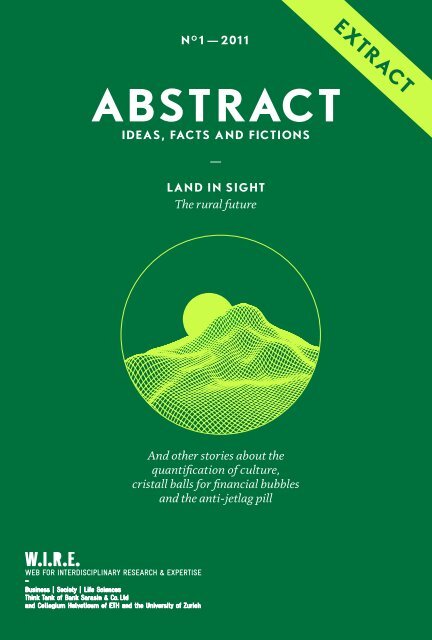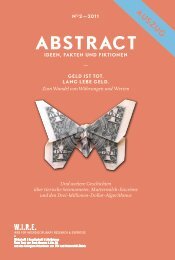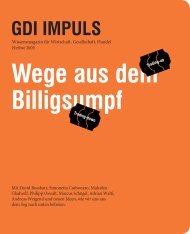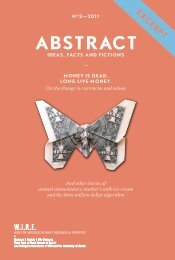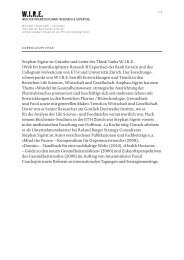ABSTRACT - W.I.R.E - The Wire
ABSTRACT - W.I.R.E - The Wire
ABSTRACT - W.I.R.E - The Wire
Create successful ePaper yourself
Turn your PDF publications into a flip-book with our unique Google optimized e-Paper software.
EXTRACT<br />
N o 1 — 2 011<br />
ABST RAC T<br />
Ideas, fActs ANd Fictions<br />
—<br />
Land in Sight<br />
<strong>The</strong> rural future<br />
And other stories about the<br />
quantification of culture,<br />
cristall balls for financial bubbles<br />
and the anti-jetlag pill<br />
48
Content<br />
Land IN SIGHT<br />
12 <strong>The</strong> differences between town and country must remain<br />
Interview with Mike Guyer<br />
20 Grabopoly<br />
By Michèle Wannaz<br />
30 Of satellites and ploughshares<br />
Interview with Jürg Minger<br />
38 More trees!<br />
By Guido Hager<br />
44 <strong>The</strong> conversion: reversing the urban sprawl<br />
By Matthias Gnehm<br />
60 If land went public …<br />
By Burkhard Varnholt<br />
62 Court martial for Iseblitz<br />
By Gerd Folkers<br />
66 Restoring the urban-rural relationship<br />
By Michael Pawlyn<br />
74 Perspectives on the rural future<br />
By Robert Huber and Alina Günter<br />
84 Metamap<br />
88 IdeAs<br />
Innovation, trends and visions that form the spirit of the age<br />
160 From Fiction to Science<br />
166 Culture & Gadgets<br />
180 Ag e n da
Restoring<br />
the Urban-<br />
Rural<br />
Relationship<br />
Cities have always depended on the countryside and the relationship<br />
has been one of extraction and depletion. This reflected<br />
a mindset that was rooted in the belief that humans<br />
could ultimately conquer nature. New approaches such as<br />
biomimicry offer the potential for a reconciliation with nature<br />
and a restorative approach to the land.<br />
By Michael Pawlyn<br />
Cities became possible when agriculture had advanced to<br />
produce a significant surplus and increasing numbers of<br />
people were released from the drudgery of food production.<br />
Urbanism therefore has always depended on the<br />
countryside and, for most of the last two millennia, that<br />
relationship has been based on a highly extractive model of<br />
land use. Perhaps the most striking example can be found<br />
in Julius Caesar who, after exhausting the fertility of the<br />
land within the empire as it then stood, embarked on a militarised<br />
shopping trip to North Africa. What he found was<br />
a wooded landscape covered with cedar and cypress trees.<br />
Over a short period the forests were cleared and farms established.<br />
For the next 200 years North Africa supplied the
LAND in Sight<br />
empire with half a million tonnes of grain per annum but,<br />
gradually, deforestation, salinisation and over-exploitation<br />
of the land took its toll. Productivity dropped, the climate<br />
changed and the Sahara desert spread northwards.<br />
<strong>The</strong> view that humans could tame the countryside<br />
and ultimately dominate nature prevailed and in many<br />
respects is still the mindset of the industrial age. Stanley<br />
Kubrick captured this brilliantly in “<strong>The</strong> Ascent of Man”<br />
which forms the twenty minute opening to “2001 a Space<br />
Odyssey” and culminates in the cut from the bone thrown<br />
into the air to the space-ship orbiting a distant planet – arguably<br />
the most stunning time-cut in cinematic history.<br />
<strong>The</strong> point that Kubrick appears to have been making was<br />
that once humans had discovered fire and learnt how to<br />
make tools and weapons, it was really just a matter of time<br />
before we dominated nature and went beyond the limits of<br />
our planet. Many of the advances that civilisation has produced<br />
are indeed miraculous, like modern medicine and<br />
the digital revolution, but we are now at a point in time<br />
that demands an urgent rethink. At the start of the industrial<br />
revolution people were scarce and resources were<br />
abundant; now we have the opposite scenario.<br />
Amory Lovins neatly captures the inadequacy of<br />
“sustainability” when he says “If you asked one of your best<br />
friends how their relationship was with their partner and<br />
they said ‘Well, it’s sustainable’ you would probably say<br />
‘I’m sorry to hear that.’” We need to move beyond sustainable<br />
to restorative ways of existing and paradoxically one<br />
of the most promising sources of solutions to our problematic<br />
relationship with nature can be found in nature itself.<br />
Biomimicry is a rapidly emerging discipline that looks<br />
to nature as a source of inspiration for innovative solu-<br />
68
tions. Comparing the design of man-made systems with<br />
the way that ecosystems operate reveals some stark contrasts.<br />
Ours tend to be simple, linear and extractive whereas<br />
natural systems are complex, cyclical and regenerative.<br />
Whereas mankind concentrates on the maximisation of a<br />
single goal, life on earth has developed into zero waste systems<br />
that run on current solar income and emit no longterm<br />
toxins. Zooming in from systems to individual species<br />
one can see some remarkable adaptations and highly<br />
efficient structures that could inspire new man-made solutions<br />
that achieve radical increases in resource efficiency.<br />
One of the simplest justifications for biomimicry would be<br />
to look at nature as being like a sourcebook of solutions<br />
that have all benefited from a 3.8 billion year research and<br />
development period and, given that level of investment, it<br />
makes sense to use it.<br />
It would be hard to find a better example of what<br />
this discipline can offer than the Namibian fog-basking<br />
beetle. This creature has evolved a way of harvesting its<br />
own freshwater in a desert. <strong>The</strong> way it does this is that, at<br />
night, it climbs to the top of a sand dune and, because it is<br />
matt black, it is able to radiate heat to the night sky and become<br />
slightly cooler than its surroundings. When the<br />
moist breeze blows in off the sea droplets of water form on<br />
the beetle’s back. <strong>The</strong>n just before sunrise it tips its shell<br />
up, the water runs down to its mouth, it has a good drink<br />
and goes off and hides for the rest of the day. <strong>The</strong> effectiveness<br />
of beetle’s adaptation goes even further because it has<br />
a series of bumps on its shell which are hydrophilic and between<br />
them is a waxy finish which is hydrophobic. <strong>The</strong> effect<br />
of this is that as the droplets form on the bumps they<br />
stay in tight spherical form which means that they are<br />
much more mobile than they would be if it was just a film
LAND in Sight<br />
of water over the whole beetle’s shell. So, even when there<br />
is only a small amount of moisture in the air, it is still able<br />
to harvest it effectively. It’s a remarkable adaptation to a<br />
resource-constrained environment and consequently, very<br />
relevant to the kind of challenges we are going to be facing<br />
over the next few decades.<br />
We have used many of these ideas in the design of<br />
the Sahara Forest Project which, ambitiously, proposes a restorative<br />
model of land use – a way in which areas of desert<br />
could be returned to vegetation. <strong>The</strong> scheme brings together<br />
two existing technologies, the Seawater Greenhouse and<br />
Concentrated Solar Power (CSP), for the first time. <strong>The</strong><br />
greenhouse uses the evaporation of seawater to create a cool,<br />
humid growing environment for crops in arid regions and<br />
condenses some of that humidity in a process that is effectively<br />
identical to the beetle. CSP uses mirrors to focus the<br />
sun’s heat to turn water to steam to drive turbines that generate<br />
electricity and this technology offers the potential to deliver<br />
vast quantities of energy to cities from the world’s deserts.<br />
One of the striking things about the first Seawater<br />
Greenhouse that was built was that it produced slightly more<br />
water than it needed for the plants inside. This surplus was<br />
spread on the land surrounding the greenhouse. <strong>The</strong> effect of<br />
this, combined with the elevated humidity created around<br />
the greenhouse, had a striking effect on the site. Prior to the<br />
project’s construction the land was largely barren; one year<br />
after completion the greenhouse was surrounded by new<br />
vegetation. In this sense the scheme went beyond “sustainable”<br />
to achieve “regenerative” design. <strong>The</strong> Sahara Forest Project,<br />
by integrating CSP with the greenhouses, aims to push<br />
this effect even further. Waste heat from the electricity generation<br />
could be used to evaporate more seawater and potentially<br />
create more fresh water while the shade created by the<br />
70
Namibian fog-basking beetle<br />
CSP mirrors make it possible to grow crops underneath that<br />
would not survive in the direct sunlight. <strong>The</strong> Sahara Forest<br />
Project is a model for how we could produce food, fresh water<br />
and clean energy in arid regions as well as restoring areas<br />
of denuded land.<br />
Our best chance of creating an abundant future lies<br />
neither in vainly trying to dominate nature nor in simply<br />
preserving small pieces of countryside, but in reaching a reconciliation<br />
with nature in which we can retain the many brilliant<br />
things that civilisation has developed but rethink the<br />
things that have proved to be poorly adapted to the long<br />
term. Biomimicry may well prove to be one of the most powerful<br />
tools in facilitating the shift from the industrial age to<br />
the ecological age of mankind and in brokering a deal between<br />
the city and the country that sees both as essential<br />
parts of the same living system.
LAND in Sight<br />
Sahara Forest Project<br />
72
Michael Pawlyn is the founder of Exploration Architecture<br />
which develops transformative design solutions to contemporary<br />
challenges. He recently delivered a talk featured on<br />
TED. Com, is currently working on the Sahara Forest Project<br />
and has written a book titled “Biomimicry in Architecture”<br />
which is due for publication in September 2011.
Contact<br />
sia@thewire.ch<br />
Editorial staff<br />
Simone Achermann<br />
Editor in chief, Researcher W.I.R.E.<br />
Dr Stephan Sigrist<br />
Head of W.I.R.E.<br />
Dr Burkhard Varnholt<br />
CIO, Bank Sarasin & Cie AG<br />
Prof. Dr Gerd Folkers<br />
Director, Collegium Helveticum<br />
Editorial contributors<br />
Daniel Bütler, Michèle Wannaz, Florian Huber,<br />
Beate Kittl, Annina Coradi, Sarah Jäggi<br />
Design<br />
Kristina Milkovic<br />
Head of Graphic Design W.I .R.E.<br />
Graphic contributors<br />
Marcel Morach<br />
Sub-editing and Printing<br />
Neidhart + Schön AG<br />
Partner<br />
Neue Zürcher Zeitung Publishing<br />
Disclaimer: this publication is for information purposes only. Inasmuch as reference is made<br />
herein to Bank Sarasin & Cie AG, this constitutes neither an offer nor an inviation by<br />
Bank Sarasin & Cie AG to purchase or sell securities. <strong>The</strong> sole aim of this publication is<br />
communication. It should also be noted that developments occurring in the past are not<br />
reliable indicators for developments in the future.<br />
Picture credits:<br />
Cover illustration: Stephan Troll (www.trollinteriors.ch)<br />
Unless otherwise noted, the rights belong to the authors or their legal successors.<br />
We have endeavoured to find the owners of all rights. Should we nevertheless not have<br />
succeeded in notifying any of the owners, they are requested to contact W.I.R.E.<br />
www.thewire.ch


